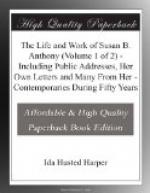At a meeting of the Trustees of the Canajoharie Academy held this day, it was unanimously Resolved to offer you the Female Department upon the terms which have heretofore been offered to the teachers of that department, viz:—the tuition money of the female department less 12-1/2 per cent., the teachers collecting their tuition bills. Should these terms meet your views, please favor us with an answer by return mail. The next term commences on the first Monday of May proximo.
We
are Very Respectfully Yours,
Joshua read, Livingston
speaker, George G. Johnson.
Miss Anthony accepted in a carefully worded and finely written letter, and arrived at the home of her uncle Joshua Saturday morning, May 2. He had lived many years at Palatine Bridge, just across the river, was school trustee, bank director, one of the owners of the turnpike, the toll bridge and the stage line, and also kept a hotel. His two daughters were well married, and Miss Anthony boarded with them during all of her three years’ teaching in Canajoharie. She found her uncle very ill and being treated by the doctor “with calomel, opium and morphine.” In a conversation he told her that “her success would depend largely upon thinking that she knew it all.” Although there was now no postmaster in the family, letter postage had been reduced to five cents, and a voluminous correspondence is in existence covering the period from 1846 to 1849. The school commenced with forty boys and twenty-five girls, and the tuition was $5 per annum. The principal was Daniel B. Hagar, a man whom Miss Anthony always loved to remember, highly educated, a gentleman in deportment, kind, thoughtful, and always ready to help and encourage the young teacher.[9]
Here Miss Anthony was for the first time entirely away from Quaker surroundings and influences, and her letters soon show the effects of environment. The “first month, second day,” expressions are dropped and the “plain language” is wholly abandoned. She has more money now than ever before and is at liberty to use it for her own pleasure. A love of handsome clothes begins to develop. “I have a new pearl straw gypsy hat,” she writes, “trimmed in white ribbon with fringe on one edge and a pink satin stripe on the other, with a few white roses and green leaves for inside trimming.” The beaux hover around; a certain “Dominie,” a widower with several children, is very attentive; another widower, a lawyer, visits the school so often as to set all the gossips in a flutter; a third is described as “very handsome, sleek as a ribbon and the most splendid black hair I ever looked at.” She takes many drives with still another, “through a delightful country variegated with hill and valley, past fields of newly-mown grass, splendid forests and gently winding rivulets, with here and there a large patch of yellow pond lilies.” In writing to a relative she urges her to break herself of “the miserable habit of borrowing trouble, which saps all the sweets of life.” At another time she writes: “I have made up my mind that we can expect only a certain amount of comfort wherever we may be, and that it is the disposition of a person, more than the surroundings, that creates happiness.”




